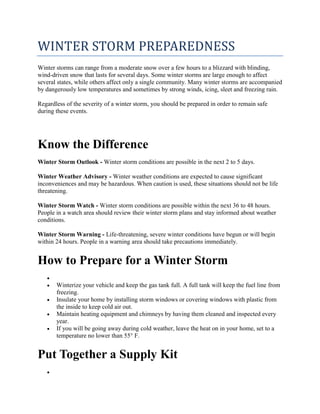Winter storm preparedness
- 1. WINTER STORM PREPAREDNESS Winter storms can range from a moderate snow over a few hours to a blizzard with blinding, wind-driven snow that lasts for several days. Some winter storms are large enough to affect several states, while others affect only a single community. Many winter storms are accompanied by dangerously low temperatures and sometimes by strong winds, icing, sleet and freezing rain. Regardless of the severity of a winter storm, you should be prepared in order to remain safe during these events. Know the Difference Winter Storm Outlook - Winter storm conditions are possible in the next 2 to 5 days. Winter Weather Advisory - Winter weather conditions are expected to cause significant inconveniences and may be hazardous. When caution is used, these situations should not be life threatening. Winter Storm Watch - Winter storm conditions are possible within the next 36 to 48 hours. People in a watch area should review their winter storm plans and stay informed about weather conditions. Winter Storm Warning - Life-threatening, severe winter conditions have begun or will begin within 24 hours. People in a warning area should take precautions immediately. How to Prepare for a Winter Storm ´éÀ ´éÀ Winterize your vehicle and keep the gas tank full. A full tank will keep the fuel line from freezing. ´éÀ Insulate your home by installing storm windows or covering windows with plastic from the inside to keep cold air out. ´éÀ Maintain heating equipment and chimneys by having them cleaned and inspected every year. ´éÀ If you will be going away during cold weather, leave the heat on in your home, set to a temperature no lower than 55┬░ F. Put Together a Supply Kit ´éÀ
- 2. ´éÀ ´éÀ WaterÔÇöat least a 3-day supply; one gallon per person per day ´éÀ FoodÔÇöat least a 3-day supply of non-perishable, easy-to-prepare food ´éÀ Flashlight ´éÀ Battery-powered or hand-crank radio (NOAA Weather Radio, if possible) ´éÀ Extra batteries ´éÀ First aid kit ´éÀ Medications (7-day supply) and medical items (hearing aids with extra batteries, glasses, contact lenses, syringes, etc.) ´éÀ Multi-purpose tool ´éÀ Sanitation and personal hygiene items ´éÀ Copies of personal documents (medication list and pertinent medical information, proof of address, deed/lease to home, passports, birth certificates, insurance policies) ´éÀ Cell phone with chargers ´éÀ Family and emergency contact information ´éÀ Extra cash ´éÀ Baby supplies (bottles, formula, baby food, diapers) ´éÀ Pet supplies (collar, leash, ID, food, carrier, bowl) ´éÀ Tools/supplies for securing your home ´éÀ Sand, rock salt or non-clumping kitty litter to make walkways and steps less slippery ´éÀ Warm coats, gloves or mittens, hats, boots and extra blankets and warm clothing for all household members ´éÀ Ample alternate heating methods such as fireplaces or wood- or coal-burning stoves Remaining Safe During a Winter Storm ´éÀ ´éÀ Listen to a NOAA Weather Radio or other local news channels for critical information on snow storms and blizzards from the National Weather Service (NWS). ´éÀ Bring pets/companion animals inside during winter weather. Move other animals or livestock to sheltered areas and make sure that their access to food and water is not blocked by snow drifts, ice or other obstacles. ´éÀ Running water, even at a trickle, helps prevent pipes from freezing. ´éÀ All fuel-burning equipment should be vented to the outside and kept clear. ´éÀ Keep garage doors closed if there are water supply lines in the garage. ´éÀ Open kitchen and bathroom cabinet doors to allow warmer air to circulate around the plumbing. Be sure to move any harmful cleaners and household chemicals up out of the reach of children. ´éÀ Keep the thermostat set to the same temperature both during the day and at night. By temporarily suspending the use of lower nighttime temperatures, you may incur a higher heating bill, but you can prevent a much more costly repair job if pipes freeze and burst. ´éÀ Go to a designated public shelter if your home loses power or heat during periods of extreme cold. ´éÀ Avoid driving when conditions include sleet, freezing rain or drizzle, snow or dense fog. If travel is necessary, keep a disaster supplies kit in your vehicle.
- 3. ´éÀ Before tackling strenuous tasks in cold temperatures, consider your physical condition, the weather factors and the nature of the task. ´éÀ Protect yourself from frostbite and hypothermia by wearing warm, loose-fitting, lightweight clothing in several layers. Stay indoors, if possible. ´éÀ Help people who require special assistance such as elderly people living alone, people with disabilities and children. Caution: Carbon Monoxide Kills ´éÀ ´éÀ Never use a generator, grill, camp stove or other gasoline, propane, natural gas or charcoal-burning devices inside a home, garage, basement, crawlspace or any partially enclosed area. Locate unit away from doors, windows and vents that could allow carbon monoxide to come indoors. ´éÀ The primary hazards to avoid when using alternate sources for electricity, heating or cooking are carbon monoxide poisoning, electric shock and fire. ´éÀ Install carbon monoxide alarms in central locations on every level of your home and outside sleeping areas to provide early warning of accumulating carbon monoxide. ´éÀ If the carbon monoxide alarm sounds, move quickly to a fresh air location outdoors or by an open window or door. ´éÀ Call for help from the fresh air location and remain there until emergency personnel arrive to assist you. Cold-Related Emergencies ´éÀ ´éÀ Frostbite and hypothermia are two dangerous and potentially life-threatening emergencies. Learn how to care for these emergencies by taking a first aid class.



